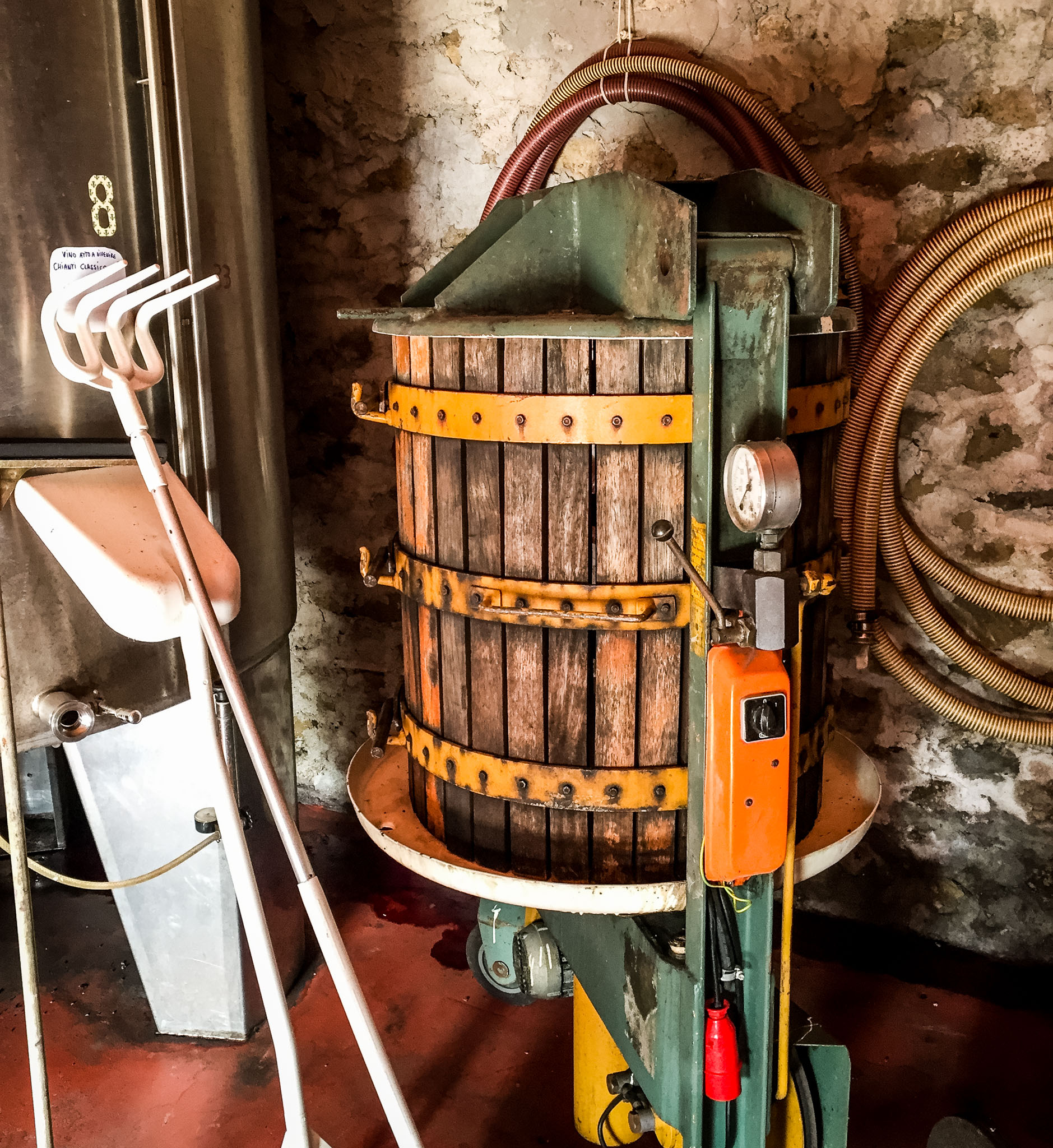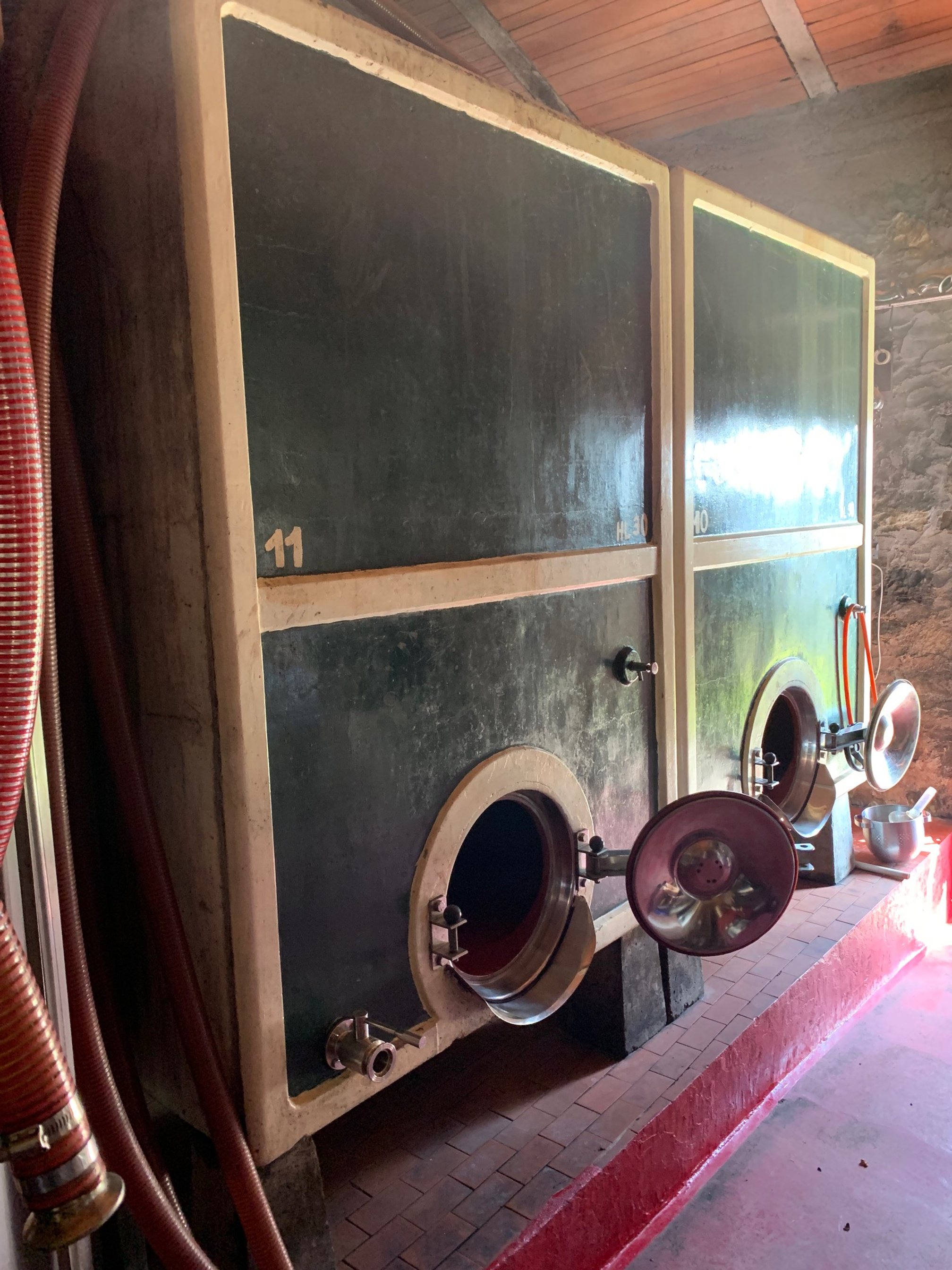






Pruneto
Who: Riccardo & Massimilliano Lanza
Where: Radda in Chianti (Tuscany, Italy)
What grapes: Sangiovese
Key fact: Two fields. 3.5 hectares. Two wines (Chianti Classico and Riserva.) 32+ years of labor and dedication.
Website: https://pruneto.it/en/en-home/
Instagram: @poderepruneto
Pruneto Chianti Classico DOCG
Viticulture: Organic
Soil type: Galestro, a friable schist mixed with chalk.
Elevation: 550m
Grapes: 95% Sangiovese, 5% Merlot
Method of fermentation: Hand picked, destemmed, fermented with native yeasts in concrete tanks then aged in very large neutral oak for 18 months and then in bottle for 4 months before release
Bottles made: 833 cases
Kirsch. Chalky. Classic. On three and a half hectares of hilly vineyard between Radda and Volpaia, Riccardo Lanza and his son Massimilliano make super-traditional, no-frills, pitch perfect Chianti Classico. Their cellar is tiny. Their barrels are large. Their Sangiovese-based wines are intended for long aging, and happily reach us once a few years have passed from harvest. If you like lovely people making honest affordable Tuscan wine in small batches, look no further. Maybe look in your fridge, for some Pecorino cheese, and spicy salami. — JM
March 2022
Massimilliano greets me at the (already covered in farm dust) Jeep Renegade that I’ve rented to traverse the low mountains of Chianti Classico. I’ve never met Massi. In the decade since I first mustered courage to climb the steep, rutted gravel road to Pruneto, he’s mostly been away at university in Bologna. In fact, he still resides in Emilia-Romagna for half the year. There are a lot of compelling reasons to live in Europe's oldest university town (tortellini, ravioli, tagliatelle, lasagna, for starters) and time away from rural Tuscany has certainly shaped Max’s view of wine. He freely admits that the beverage his father and grandfather made for 30+years was of little personal interest, until he encountered it recontextualized in Bologna. “I mostly drank gin and tonics.” An array of urban wine bars pouring a more progressive take on the drink allowed Max to grow appreciation for work his family were doing, and to cultivate enthusiasm for continuing this labor back at home.
Unsurprisingly, Massimilliano’s father makes a grand entrance. After being summoned, Riccardo saunters from the stone farmhouse to shake hands and stand around in the unseasonably warm sun of a midmorning in late March. “You’ve gained a few kilos since we last met,” is his opening salvo. True, and funny. Covid kept us apart since 2019, and mostly kept one of us on his butt. Isolation is never ideal, but a sundrenched hillside, surrounded by forest and vine, facing a centuries-old convent across a wide valley: Riccardo’s quarantine landscape was close enough to perfect. There were hardships. But he had room to roam, and vines to tend. And now he gets to hold court.
“Now I have a boss.” Riccardo’s view of the return of his eldest to the property is a winking misrepresentation of their working relationship. It’s clear that Max remains deferential to Riccardo, fundamentally receptive to his advice. It’s also apparent that change is afoot. The cellar is cleaner than I’ve ever seen it. A new field has been cleared, and young vines planted. To support a new generation, the farm must grow. At least a little.
Blunt farmer assessment of the passage of years eases us into conversation about new wines. We move to the shade of a tree covered in honeysuckle, and surround a picnic table covered in wine and cheese. Remarkably, there’s a new wine at Pruneto. It’s called de Mode, and it bears the fingerprint of Massimilliano’s time in Bologna. The aromas are a tad more natural, the texture less doggedly traditional for Radda than anything I've tasted from the farm before. In sum, the wine is fruity, accessible, and good. I like the impression it makes on the palate. Irreverence, life. And I like that Max has found something worthwhile to do with the small amount of Merlot grown at the estate. De Mode is 70% Merlot and 30% Sangiovese. Its style plays to the strengths of the former grape.
The marquee wines at Pruneto need more oxygen to reach full flight than most reds. This is true even in comparison to other traditional Chianti Classicos from nearby addresses. I regret that the decanter isn’t omnipresent in restaurant wine service, because Riccardo’s wines have a tendency to change from good to brilliant once half the bottle is poured. I think this difficult-to-explain trait must be a reflection of the man as much as the land. Soil at Pruneto is a mix of gallestro in the steepest vineyard, and clay/albarese in the lower of the family’s two sites. In short, it’s the classic geology for Chianti Classico, well-suited to Sangiovese, and not (on its own) enough to explain the reserved style of the bottled wine.
In Pruneto’s two small cellars we view a short row of enamel-lined cement tanks, and a handful of large old wooden casks. Two of these massive vessels are enough to contain the total production of the farm in a normal vintage. Three and a half hectares of old vines don’t produce much fruit, and the age of the vines (and a series of hot, dry vintages) means that (at best) 70% of the total fruit weight is extracted as juice before fermentation. Given the infernally hot summers Tuscany has been experiencing, I’m surprised (and delighted) to find that the 2019 Chianti Classico isn’t even a bit heavy. Despite rising to 13.5% abv (uncommon at this estate) the wine seems very traditional. Chalky, dry, fresh red fruit. Massimiliano explains that at Pruneto the vineyards are so close to the cellar that fruit can be harvested and then hustled into a relatively cool room in a matter of minutes. By processing the grapes almost exactly when you pick them, freshness is retained.
Riccardo steps away to smoke a cigarette. Max talks about the benefit of having a strong relationship with other farmers in the zone. The Vignaioli di Radda organisation shares know-how and equipment, which is invaluable in the community. Radda is the heart of Chianti. It has a history that stretches back eight centuries. But the place is remarkably small, at least in comparison to other Chianti Classico communes. Good neighbours lift the overall quality of Radda’s wine.
We taste the 2019 Riserva, made from a single, higher-elevation site full of 50-year-old vines. The wine is impressive, more cassis-kirsch in aroma than the duo’s “normal” Chianti Classico. The texture is plush, seamless.
Succession plans were on my mind almost from the start at this estate. Riccardo isn’t too too old, but he plays the role of an ancient codger to the hilt. On my second visit, in 2013, I remember him lamenting his children’s lack of interest in working the land around his farm. I think he was exaggerating. His daughter is around the farm, taking care of the agriturismo. It is assuring to meet Massimiliano, to get a sense of his character. He’s amiable, and full of energy. I like his ideas. I also like the relationship he shares with Riccardo. I think things will change at Pruneto in the years ahead. But not too much.
Pruneto is a nice old farmhouse on top of a hill surrounded by vineyards. Riccardo’s father bought it in the late 1960’s. Previously their family lived in Milan. “My father bought it because it was cheap, not destroyed but basically just a shell of a house.” He paid the equivalent of 3,200 euros for the house, vineyards and olive groves.
“Only poor people lived here (at that time)” Lanza said. “The work was too hard. During the economic boom (after World War II) people moved to Poggibonsi, to towns near railways and autostrada.”
Riccardo Lanza was busy arranging a 40-year reunion party for his graduating class when I arrived. He went to university for agriculture. After graduation he worked in Lombardy, south of Milan. In 1980 Pruneto’s one farm worker retired, and Riccardo took over.
His father was attracted to Pruneto through friendship with seminal, legendary resident Sergio Manetti of Montevertine.
Riccardo Lanza between vineyard and cellar.
“Sergio was a little genius. He was also the right person at the right place. He invented something, pure Sangiovese.”
The view from Riccardo’s steep, winding driveway is exceptional, steep hills covered with vines. Across the valley is an impressive centuries-old estate that apparently used to be a monastery. Many farmhouses have been converted into vacation homes and villas. The clean air and bucolic setting may add to Riccardo’s propensity to philosophize.
“This is the history of Italy over the last 3,000 years. We think we are the best. It’s not true… but we copy the French.” Lanza and his father were inspired by Sergio Manetti’s courage to do something authentically Italian.
“It’s not easier to make a bad wine… OK maybe good wine is a little harder to make (but not much.)”
Riccardo has a son and a daughter, but they are not interested in making wine, at least at present. “It’s difficult for a young person to understand. I like to live in the country. I prefer to work in the country, not in the cellar. I have wonderfully positioned vineyards.”
The estate is tiny, 3.5 hectares divided into just two vineyards, surrounded by forest. The older site is west-facing and was planted in 1972. Lanza says he never has to worry about sunburned grapes from this field. His other parcel was planted in 1999, and is surrounded on all sides by forest. Lanza describes with wonder the experience of walking through the forest to this hidden vineyard. All his vines grow at a temperate 550 meters above sea level.
In the cellar Lanza uses large barrels and simple equipment to make his wines. He has used the same press for 31 years. The cellar is clean, but not high-tech. “It’s difficult to find the right machine for me. I am low-tech.”
“The wine-making world is all about power. Which is why I prefer to grow grapes, or potatoes, or tomatoes.”
Riccardo Lanza makes Chianti Classico that lives up to its prestigious designation. His work defines and frames a real view of Radda. Tasting real Sangiovese likes Pruneto’s emphasizes how this grape is still underrated and under-appreciated, even in Italy. Sangiovese can make the best red wine, and is the flavor of Tuscany.

